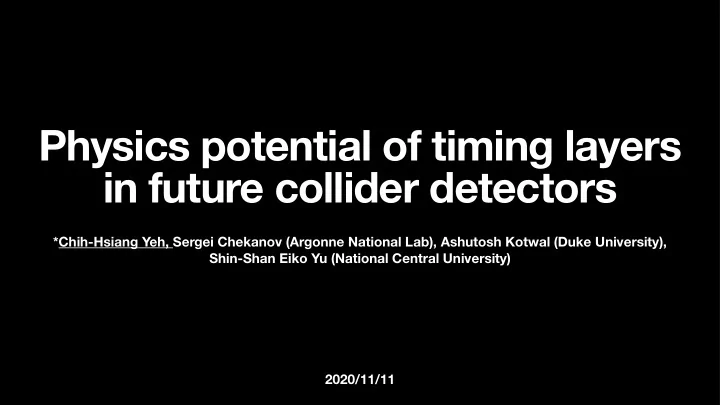

Physics potential of timing layers in future collider detectors *Chih-Hsiang Yeh, Sergei Chekanov (Argonne National Lab), Ashutosh Kotwal (Duke University), Shin-Shan Eiko Yu (National Central University) 2020/11/11
Outline • Motivation • Publication • Software and Structure • Showcases • Conclusion 2
Motivation
Motivation Add Timing Info • Future colliders: • FCC, CEPC, CLIC • High-precision measurements of particles/jets • 5D information(position, energy, timing) • Improve particle/jet reconstruction • Suppress the background • CPAD report: Critical needs of Calorimeters (https://arxiv.org/pdf/1908.00194.pdf) • Pico-second resolution
Publications
Publications of our studies References • Initial performance studies of a general-purpose detector for multi-TeV physics at a 100TeV pp collider [JINST/P06009] • Talking about the structure of our SiFCC detectors and energy resolution → • Studies of granularity of a hadronic calorimeter for tens-of-TeV jets at a 100 TeV pp collider[JINST/P05008] • Talking about the e ff ect of HCAL granularity → 6
Publications of our studies References • The Latest one! • Physics potential of timing layers in future collider detectors[JINST/P09021] • Talking about the timing applied to identify single particle species → • Mainly included in this talk → 7
Software and Structure
Software and Structure • Full GEANT4 simulation with SiFCC detectors • Length between TL1 and TL2: 24cm • ECAL hits information used to measure the timing di ff erence TL1 and TL2 • 2 x 2( 𝖽𝗇 𝟥 ), 35 𝖸 𝟣 • Material: Silicon 9
The advantage of TL2 • Identify the stable massive particles [BSM particles] “without knowing a production vertex” • Mitigate the situations when the primary vertex position is smeared. • Correlated with the first layer (TL1), which can provide the directionality of the particle back-scattered hits can be identified. → 10
Showcases
Capability of timing 𝖴 𝖴𝖬𝟥 − 𝖴 𝖴𝖬𝟤 = 𝖴 GEANT4 Simulation! Leading in time hits Distinguishable! Non-distinguishable! Peak: 0.5ns Peak: 0.5ns Peak: 0.5ns Landau peak: 0.7ns Mean: 1.4ns (1) Resolution: 1ns Peaks are smaller than 1ns Seen as instantaneous hits → (2) Resolution: 10ps Distinguish the di ff erent particles apart(1GeV) 12
Semi-analytic 3- hypothesis σ L: Length of particle’s trajectory : Resolution of the detector σ 𝖴𝖯𝖦 m: Particle mass p: Momentum of particle ( JHEP 04 (2019) 037 [arXiv:1807.05453)] : Reference particle mass 𝗇 𝖦 If the condition is met, particle can be distinguished from 𝗇 𝗇 𝖦 13
The showcase of 3- hypothesis σ L= 2m from vertex to ECAL General cases BSM studies 3GeV 700GeV 0.4GeV 70GeV K mesons from Pions Heavy particle(BSM) from particle(BKG) α W ith 1ns resolution, 300MeV-500MeV can be achieved=>Not enough for FCC! Minimum~0.5GeV 14
Another case TL2 L=0.2m from TL1 to TL2 0.2m TL1 200GeV 15GeV 100GeV Heavy particle(BSM) from particle(BKG) α Beneficial for particles produced in events with large pile-up (multiple pp interactions)! Also, we don’t need to know about the interaction vertex 15
Showcase of Dark QCD model Decay JHEP 05 (2015) 059 SM quark P M X → Dark quark Dark Pion Emerging jet SM quark P M X → Dark Pion Emerging jet Dark quark Test the capability of using the timing to tag the Dark Pion 16
Setup particle ( ) m F α CMS SiFCC Momentum of Dark Pion(p) Momentum of Dark Pion(p) L=1.2m L=2m Production Vertex to ECAL(L) s = 𝟤𝟦𝖴𝖿𝖶 s = 𝟥𝟪𝖴𝖿𝖶 Dark Pion( m ) 17
Track acceptance vs. Calorimeter with the timing Dark Pion Mass=5GeV, Varying the ctau and Mediator Mass JHEP 02 (2019) 179 Cover the di ff erent ranges! 18
Emerging jets with the same condition as CMS Dark Pion Mass=5GeV, Varying the ctau and Mediator Mass With the higher lifetime With the higher resolution The acceptance is higher! 19
Emerging jets for HL-LHC with SiFCC Mediator Mass=10TeV, Varying the ctau and Dark Pion mass With the higher lifetime With the higher resolution The acceptance is higher! 20
Conclusion
Conclusion • Timing layers with tens of picosecond capabilities complement calorimeters with the standard ~0.5 - 1 ns readout • Overwhelming benefits for BSM long-lived particles • Other expected benefits: • Particle identification (baryons vs pions vs kaons etc.) • Reducing confusion terms in particle flow algorithm → improvements for jets etc. • b-tagging, etc. • To be quantified using realistic Monte Carlo simulations • Survey for best technology for timing layers is ongoing 22
Thank you for your attention! Q&A TIME
Recommend
More recommend